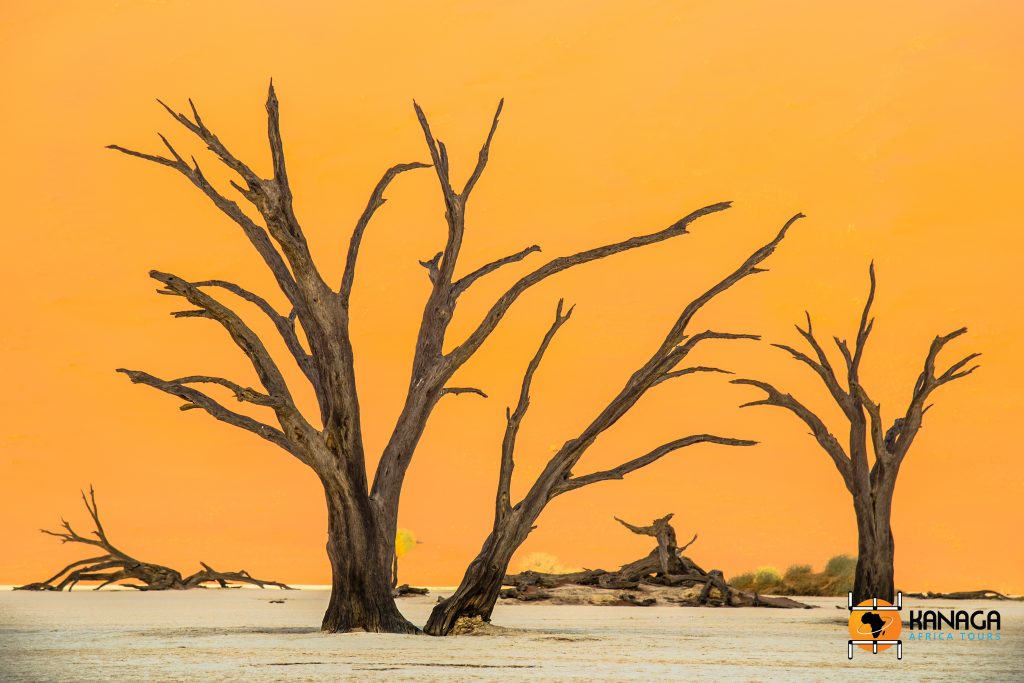The Namib, considered to be the oldest and driest desert in the world, is certainly also one of the most astonishing, with its monumental dunes, petrified acacia forests, an extraordinary microclimate that allows the survival of endemic flora and fauna, and scenic ghost towns, engulfed in diamond sands tinged with red, pink, orange and ochre. A unique desert of rock and sand that flows directly into another desert made of water, the Atlantic Ocean, populated by whales and sea lions. The Namib, with its naturalistic surprises and colour ranges, will enchant and amaze even the most experienced traveller.
The first images that come to mind when one thinks of the Namib are the incredible desert landscapes of Sossusvlei, nestled between the world’s highest and most colourful dunes. We are in the heart of the Namib-Naukluft National Park, an immense eco-region that stretches parallel to the Atlantic coast, between the colonial towns of Luderitz in the south and Swakopmud and Walvis Bay in the north, extending its course through the Namib’s stony interior glades and the rocky canyons of the Moon Valley, ascending northwards towards the borders of Damaraland, and plunging westwards directly into the ocean, past the high dune belts of spectacular Sandwich Harbour, to the Skeleton Coast with its impressive early 20th century shipwrecks.
True monuments of nature, each dune on Sossusvlei is given a name. Dune 45, the most scenic to climb, Big Daddy and Dune 7, the highest in the world (over 300 metres), and Dead Vlei, the famous dried-up salt flat, with its light soil tones contrasting with the grey of the petrified acacia trunks, and with the surrounding dunes that change colour continuously depending on the time of day. Surreal shades of white, ochre, pink, red, orange and the blue of the sky, for one of the most photographed spectacles of nature in the world.
With less than 20 millimetres of annual rainfall, dog days and glacial nights, the Namib Desert has a special microclimate that allows the miraculous survival of numerous endemic species of flora and fauna, thanks to the thermal moisture that forms in the collision with the cold ocean current of the Benguela, and that envelops everything in fog and condensation up to 60 km inland. Chameleons, beetles, vipers and lizards, as well as ostriches, hyenas and jackals, feed and hydrate on termites and condensation from the fog, which also allows sporadic vegetation to grow on the edge of the dune belts, feeding the oryxes, Namibia’s iconic animals, which have developed the ability to raise their body temperature above 40 °C during the hottest hours to prevent water loss. An extraordinary ecosystem that is reflected in the beauty of the surrounding landscape, desolate and magical at the same time.
It is precisely the phenomenon of the mists that has caused the highest number of shipwrecks in the world, populating the Namib’s coastline, the so-called Skeleton Coast, with human skeletons of sailors and the skeletons of ships that ran aground in the past centuries among the shoals emerging from the water and that today, with the advancing sands, are partly completely beached. A fascinating spectacle, which is now an integral part of the coastal landscape, home to some of the most populous colonies of sea lions in the world, as well as whales, sharks, dolphins, pelicans and pink flamingos. A coastline populated by aquatic fauna, and inhabited by man only in sporadic settlements founded in colonial times. Small towns where the first German settlers settled, with the intention of developing the mining industry, iron and especially diamonds, and deep-sea fishing. Small branches of the Rhine in the middle of the coastal desert, the towns of Luderitz, Swakopmud and Walvis Bay.
From Luderitz, within easy reach are the early diamond settlements of Kolmanskop, Elisabeth Bay or Pomona, now abandoned and swallowed up by the Namib dunes, ghost dwellings that, like the shipwrecks, or the abandoned cars of Solitaire, are now part of this desert land that has inexorably engulfed them, forever.







